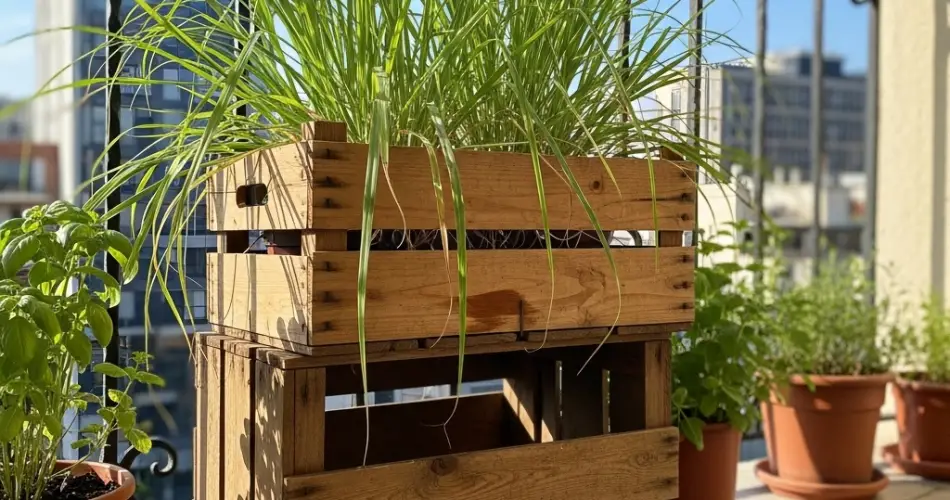Lemongrass (Cymbopogon citratus) is a tropical herb celebrated for its bright, citrusy flavor and aromatic fragrance. Its stalks and leaves are commonly used in teas, soups, curries, marinades, and stir-fries, adding freshness and complexity to dishes. Urban gardeners with limited space can enjoy this versatile herb by growing it in wooden crates on a balcony, combining convenience, sustainability, and visual appeal in a compact setup.
Balcony crate gardening is ideal for apartments, patios, and small terraces. Wooden crates are lightweight, portable, and easy to maintain, allowing you to move plants to optimize sunlight or protect them from wind and rain. They also create a rustic, natural aesthetic, making your balcony both productive and visually appealing.
Selecting the Right Crate
Choosing an appropriate crate is essential for the healthy growth of lemongrass.
Size and Depth
-
Opt for crates at least 12 inches deep to accommodate lemongrass’s developing root system.
-
Ensure the crate is wide enough to grow multiple stalks or a single plant comfortably, typically 12–18 inches across.
Drainage
-
Drill several small holes in the bottom to prevent waterlogging.
-
Elevate the crate slightly on bricks or small stands to allow excess water to drain freely.
Proper crate selection ensures stable growth and prevents root rot, which can occur in poorly drained containers.
Choosing Lemongrass Stalks
Healthy stalks are crucial for successful growth in crates.
Selection Tips
-
Choose firm, fresh stalks with intact white bases and small root nodes if possible.
-
Avoid wilted, dry, or damaged stalks.
-
Fresh, vigorous stalks establish roots faster and produce stronger plants.
Starting with high-quality stalks gives your crate garden the best chance for a productive harvest.
Water Propagation Before Planting
Water propagation encourages root development before transferring stalks to soil-filled crates.
Steps
-
Trim stalks to leave 4–6 inches from the base.
-
Remove any dried outer layers.
-
Place stalks in shallow water, ensuring the bottom 2–3 inches are submerged.
-
Change the water every 2–3 days to keep it fresh and prevent bacteria buildup.
Roots typically form within a week, signaling readiness for planting in soil.
Planting Lemongrass in Crates
Once roots are visible, transfer stalks to prepared crates.
Soil Preparation
-
Use a well-draining, fertile potting mix with added compost or organic matter.
-
Avoid dense, heavy soil that can hinder root expansion.
Planting Steps
-
Fill the crate with soil, leaving 1–2 inches from the top.
-
Insert rooted stalks into the soil, spacing them 6–8 inches apart.
-
Gently press the soil around each stalk and water thoroughly to settle the roots.
Well-planted stalks establish quickly and support healthy, consistent growth.
Sunlight and Temperature
Lemongrass requires bright sunlight and warm conditions for optimal development.
Light Requirements
-
Place the crate in a sunny location with at least 6–8 hours of direct light daily.
-
Rotate crates occasionally to ensure even exposure on all stalks.
Temperature Guidelines
-
Lemongrass thrives between 70–85°F (21–29°C).
-
Protect plants from frost, cold drafts, or extreme heat.
Adequate light and temperature encourage strong stalks and flavorful leaves.
Watering and Maintenance
Consistent watering and care are essential for healthy lemongrass growth.
Watering Tips
-
Keep the soil evenly moist but not waterlogged.
-
Check the top inch of soil daily and water as needed.
-
Water at the base of the stalks to prevent wet foliage, which can encourage disease.
Maintenance Practices
-
Harvest outer stalks regularly to encourage bushier growth.
-
Remove yellowing or damaged leaves to maintain plant health.
-
Fertilize every few weeks with a balanced, organic fertilizer to support continuous growth.
Routine care ensures strong, productive plants throughout the growing season.
Harvesting Lemongrass
-
Stalks can be harvested once they reach 12 inches or taller.
-
Cut outer stalks at the base, leaving inner stalks to continue growing.
-
Frequent harvesting encourages fuller, healthier plants.
-
Use fresh stalks immediately in cooking, or store them in the refrigerator for later use.
Balcony crates make harvesting convenient, allowing you to enjoy fresh lemongrass whenever needed.
Styling Your Balcony Crate Garden
-
Arrange multiple crates side by side or stack them for a layered display.
-
Combine lemongrass with other aromatic herbs such as basil, mint, or parsley.
-
Choose decorative crates or paint them to complement your balcony’s aesthetic.
A well-planned crate garden enhances the balcony visually while keeping fresh herbs within easy reach.
Benefits of Crate Gardening for Lemongrass
-
Maximizes limited balcony space for herb cultivation.
-
Provides year-round access to fresh, fragrant stalks and leaves.
-
Reuses wooden crates, supporting sustainable gardening practices.
-
Creates a functional and attractive green feature for urban living.
Final Thoughts
Growing lemongrass in crates on your apartment balcony is a simple, efficient, and eco-friendly solution for urban gardeners. By selecting healthy stalks, preparing nutrient-rich soil, providing sufficient sunlight, and maintaining consistent care, lemongrass can thrive in compact spaces.
This method ensures a steady supply of fresh, aromatic stalks for cooking while transforming ordinary crates into a productive and visually appealing balcony garden. With minimal effort, gardeners can enjoy the convenience, sustainability, and beauty of a balcony lemongrass crate garden year-round.



